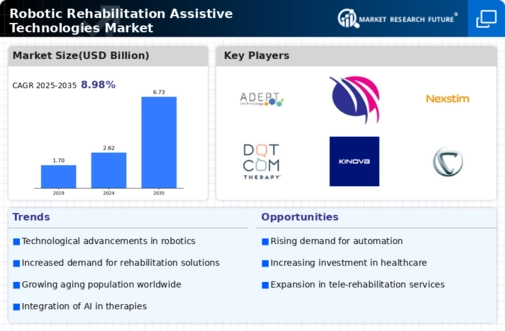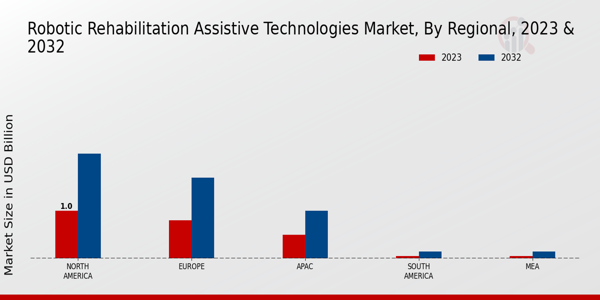Market Growth Projections
The Global Robotic Rehabilitation Assistive Technologies Market Industry is projected to experience substantial growth over the next decade. With a market valuation of 2.62 USD Billion in 2024, it is anticipated to reach 6.73 USD Billion by 2035, reflecting a CAGR of 8.97% from 2025 to 2035. This growth trajectory indicates a robust demand for innovative rehabilitation solutions driven by technological advancements and increasing healthcare investments. The market's expansion is likely to be fueled by the integration of robotics in rehabilitation practices, enhancing patient outcomes and operational efficiencies across healthcare systems.
Technological Advancements in Robotics
Rapid advancements in robotics technology significantly influence the Global Robotic Rehabilitation Assistive Technologies Market Industry. Innovations such as artificial intelligence and machine learning enhance the capabilities of rehabilitation robots, allowing for more personalized and adaptive therapy. These technologies enable real-time feedback and adjustments, improving patient engagement and outcomes. As a result, the market is projected to grow from 2.62 USD Billion in 2024 to 6.73 USD Billion by 2035, with a CAGR of 8.97% from 2025 to 2035. This growth is indicative of the increasing reliance on advanced robotic systems in rehabilitation settings.
Growing Awareness of Rehabilitation Benefits
There is a growing awareness of the benefits associated with robotic rehabilitation technologies, which positively impacts the Global Robotic Rehabilitation Assistive Technologies Market Industry. Patients, healthcare providers, and policymakers are increasingly recognizing the effectiveness of robotic systems in enhancing recovery processes. This awareness fosters greater acceptance and adoption of robotic rehabilitation solutions across various healthcare settings. As educational initiatives and outreach programs proliferate, the market is likely to experience accelerated growth. The emphasis on improving quality of life through advanced rehabilitation technologies underscores the potential for sustained market expansion.
Rising Investment in Healthcare Infrastructure
The Global Robotic Rehabilitation Assistive Technologies Market Industry benefits from increased investment in healthcare infrastructure, particularly in developing regions. Governments and private sectors are recognizing the importance of advanced rehabilitation technologies in improving patient care. This investment leads to the establishment of specialized rehabilitation centers equipped with robotic systems. As healthcare systems evolve, the demand for innovative rehabilitation solutions rises, potentially expanding market opportunities. The focus on enhancing patient outcomes through technology-driven rehabilitation aligns with global health initiatives, suggesting a robust future for the industry.
Increasing Prevalence of Neurological Disorders
The rising incidence of neurological disorders, such as stroke and Parkinson's disease, drives the Global Robotic Rehabilitation Assistive Technologies Market Industry. As the global population ages, the demand for rehabilitation solutions intensifies. In 2024, the market is valued at 2.62 USD Billion, reflecting the urgent need for effective rehabilitation technologies. These disorders often require extensive rehabilitation, which robotic technologies can facilitate through precise and consistent therapy. The integration of robotics in rehabilitation not only enhances recovery outcomes but also reduces the burden on healthcare systems, indicating a promising trajectory for market growth.
Aging Population and Increased Demand for Rehabilitation
The aging global population is a critical driver for the Global Robotic Rehabilitation Assistive Technologies Market Industry. As individuals age, they often face mobility challenges and require rehabilitation services to maintain independence. The demographic shift towards an older population necessitates innovative solutions to address these challenges. This trend is expected to contribute to the market's growth, with projections indicating a rise from 2.62 USD Billion in 2024 to 6.73 USD Billion by 2035. The increasing demand for effective rehabilitation solutions tailored to the elderly population highlights the importance of robotic technologies in meeting these needs.












